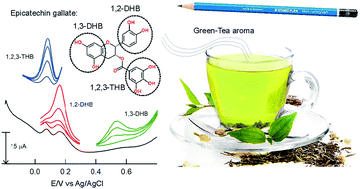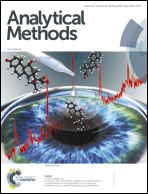Tea quality testing using 6B pencil lead as an electrochemical sensor
Abstract
Isomers of dihydroxy benzene (DHB) such as 1,2-DHB, 1,3-DHB and 1,2,3-trihydroxy benzene (1,2,3-THB) are the functional constituents of tea polyphenols. Herein, we report an elegant 6B pencil lead for real-time tea quality assessment via a simple and quick procedure to electrochemically detect polyphenols in a mixture without any adsorption complication. A pre-anodised 6B-PGE, denoted as 6B-PGE* has showed well-defined anodic signals without any separation technique for the dihydroxy (DHB) and trihydroxy benzene derivatives present in tea polyphenols at distinct potentials. Differential pulse voltammetry was adopted for the quantification procedure. The constructed calibration plots were linear in the windows, 10–100 μM, 50–350 μM and 10–70 μM for 1,2-, 1,3- and 1,4-DHB isomeric derivatives, respectively. The calculated sensitivity and detection limit (signal-to-noise ratio = 3) values were 0.2234, 0.0725 and 0.0627 μA μM−1 and 0.719, 2.469 and 5.072 μM, respectively. Quantification of the polyphenolic content in two different tea dust samples was demonstrated as representative examples.



 Please wait while we load your content...
Please wait while we load your content...